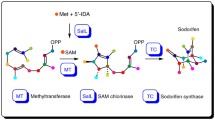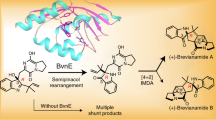Abstract
THE Channon–Chibnall mechanism1 for the biogenesis of long-chain ketones of the form R·CO·R from 2R·CO2H affords a natural explanation of the frequent location of the carbonyl group at the midpoint of the chain. The explanation has been accepted by most biochemists, especially after this route was proved, by the 14C tracer method, to be followed in the biosynthesis of corynomycolic acid (I)2.  A natural corollary has been the assumption that long-chain hydrocarbons, such as hentriacontane, are biogenetically derived by reduction processes from ketones made by the Channon–Chibnall mechanism. It should be noted, however, that the naturally occurring long-chain hydrocarbons do not obey the implied rule in a very satisfactory way. Nonacosane, probably the most widely distributed hydrocarbon of all, is accompanied in many petroleums by the normal C27 and C31 alkanes which are each more abundant than neighbouring hydrocarbons with an even number of carbon atoms, but occur in only about half the quantity of nonacosane.
A natural corollary has been the assumption that long-chain hydrocarbons, such as hentriacontane, are biogenetically derived by reduction processes from ketones made by the Channon–Chibnall mechanism. It should be noted, however, that the naturally occurring long-chain hydrocarbons do not obey the implied rule in a very satisfactory way. Nonacosane, probably the most widely distributed hydrocarbon of all, is accompanied in many petroleums by the normal C27 and C31 alkanes which are each more abundant than neighbouring hydrocarbons with an even number of carbon atoms, but occur in only about half the quantity of nonacosane.
This is a preview of subscription content, access via your institution
Access options
Subscribe to this journal
Receive 51 print issues and online access
$199.00 per year
only $3.90 per issue
Buy this article
- Purchase on Springer Link
- Instant access to full article PDF
Prices may be subject to local taxes which are calculated during checkout
Similar content being viewed by others
References
Channon, A. J., and Chibnall, A. C., Biochem. J., 23, 168 (1929).
Gastambide-Odier, M., and Lederer, E., Nature, 184, 1563 (1959).
Robinson, R., Catalyst (Indust. J. of Shell Chem. UK, Ltd), 6, 51 (1961).
Kolattukudy, P. E., Biochemistry, 4, 1844 (1965).
Kolattukudy, P. E., Biochemistry, 5, 2265 (1966).
Kolattukudy, P. E., Phytochemistry, 6, 965 (1967).
Kolattukudy, P. E., Plant Physiol., 43, 375 (1968).
Kaveda, T., Biochemistry, 6, 2023 (1967).
Tornabene, T. G., and Oro, J., Bacteriology, 94, 349 (1967).
Tornabene, T. G., Oro, J., and Gelpi, E., Bacteriology, 94, 333 (1967).
Chibnall, A. C., and Piper, S. H., Biochem. J., 28, 2008 (1934).
Kuwata, T., J. Amer. Chem. Soc., 60, 559 (1938).
Robinson, G. M., J. Chem. Soc., 745 (1930).
Piper, S. H., Chibnall, A. C., Hopkins, S. J., Pollard, A., Smith, J. A. B., Williams, E. F., Biochem. J., 25, 2072 (1931).
Traschchenko, A. J., and Limasova, I. I., Izv. Sibirsk. Obot. Alsad. Nauk SSSR., Ser. Khim. Nauk (2), 90 (1965).
Author information
Authors and Affiliations
Rights and permissions
About this article
Cite this article
KOLATTUKUDY, P., JAEGER, R. & ROBINSON, R. Biogenesis of Nonacosan-15-one in Brassica oleracea : Dual Mechanisms in the Synthesis of Long-chain Compounds. Nature 219, 1038–1040 (1968). https://doi.org/10.1038/2191038a0
Received:
Issue Date:
DOI: https://doi.org/10.1038/2191038a0
This article is cited by
-
Moving beyond the ubiquitous: the diversity and biosynthesis of specialty compounds in plant cuticular waxes
Phytochemistry Reviews (2018)
-
Incorporation of oxygen‐18 into secondary alcohols of grasshopperMelanoplus sanguinipes
Lipids (1975)
-
Composition of the surface lipids of pea leaves (Pisum sativum)
Lipids (1970)
-
Plant waxes
Lipids (1970)
-
Chemical Genetics of Nonacosan-15-one and Related Compounds in Brassica oleracea
Nature (1969)
Comments
By submitting a comment you agree to abide by our Terms and Community Guidelines. If you find something abusive or that does not comply with our terms or guidelines please flag it as inappropriate.



